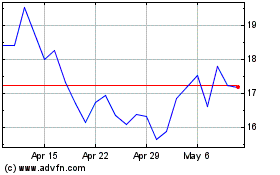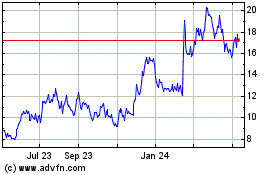By Tim Higgins and Parmy Olson
Uber Technologies Inc. is cutting about 14% of its workforce
and, along with smaller rival Lyft Inc., is looking for more ways
to save money as their ride-hailing businesses have dropped
dramatically amid the coronavirus pandemic.
The pandemic has challenged the very business model that
supercharged Uber and Lyft into some of the world's most valuable
startups. The the San Francisco-based ride-sharing companies now
face questions about consumers' willingness to participate in the
sharing economy at a time when health experts and government
officials are recommending sheltering in place and avoiding
contact.
In addition, before the pandemic, both companies had been trying
to improve their profitability as investors grew increasingly
worried about hefty losses they were incurring in their rush to
grow.
Wednesday, Uber said Wednesday that it was cutting about 3,700
workers and that Chief Executive Dara Khosrowshahi agreed to waive
his base salary for the rest of the year. Last week, Lyft said it
was cutting 17% of its workforce and putting some employees on
unpaid furloughs as well as trimming salaries.
Mr. Khosrowshahi, in a memo to employees, hinted at more cuts to
come, telling workers that Wednesday's job reductions were part of
a broader exercise to adjust the company's cost structure and that
he expected a further and final update on that effort within the
next two weeks.
"We are looking at many scenarios and at each and every cost,
both variable and fixed, across the company," he said in the memo.
"We want to be smart, to move fast, to retain as many of our great
people as we can, and treat everyone with dignity, support and
respect."
The CEO acknowledged the pain of the action in his Wednesday
memo: "Days like this are brutal."
Lyft on Wednesday posted a loss of $398.1 million on sales of
$995.7 million. The company's net loss of $1.1 billion in the
year-ago period included an $859 million hit from stock-based
compensation tied to its initial public offering in March 2019. The
loss figure for the first three months of this year missed Wall
Street's scaled back expectations even as sales came in
stronger.
Uber reports its earnings Thursday.
Lyft ridership still grew 3% in the three months through March
31 from the year-ago period, but the first quarter also gave an
early hint at the impact of the Covid-19 outbreak. The company said
the number of active riders taking a Lyft trip declined to 21.2
million in the first quarter from 22.9 million in the October
through December period. It marked the first sequential drop in
ridership since the startup became a public company.
The company has since suspended its full-year guidance because
of uncertainty about the business effects from the pandemic and
shelved a commitment to post its first profitable quarter on an
adjusted basis by the end of next year. Lyft reported a loss before
interest, taxes, depreciation and amortization on an adjusted basis
of $85.2 million compared with a loss of $216 million on that basis
in the year-earlier period.
"We are responding to the pandemic with an aggressive cost
reduction plan that will give us an even leaner expense structure
and allow us to emerge stronger," Lyft co-founder and CEO Logan
Green said in a statement.
The company said cost savings measures it is implementing will
reduce annualized expenses about $300 million by the fourth quarter
of this year compared with previous projections. Lyft said it would
incur $28 million to $36 million in costs related to the job cuts
that would largely book in the current quarter. The company also
has furloughed some staff and cut pay for others.
Lyft said it ended the quarter with $2.7 billion of cash and
other funds it can quickly tap.
Meanwhile, expectations for the three months through June are
worse.
Analysts expect Lyft's sales in the current second quarter to
total $560.8 million, half of what was expected in this period by
analysts at the end of February and down 35% from the year-ago
quarter, according to FactSet. Uber's current-quarter sales are
only projected to drop 7% year-over-year to $2.93 billion, but that
same estimate was at $4.26 billion at the end of February, FactSet
said.
"The impact on the sharing economy will be enormous, even
devastating," said Stephanie Balaouras, a vice president at
Cambridge, Mass.-based Forrester Research Inc. who studies tech
operations.
Uber's share price, off 5.6% in 2020 through Tuesday, has held
up better than Lyft's, which is down 38% this year, in part because
of its food-delivery operations. Online ordering from grocery
stores and restaurants has surged since the U.S. declared a
national emergency in March.
Analysts will be looking closely at Uber's results to better
understand what an increase of its Eats food-delivery business
means to the bottom line. Gross bookings of Eats deliveries may
rise 42% in the first quarter from a year ago, according to the
average estimate of analysts surveyed by FactSet, while staying
roughly in line with the fourth quarter.
Mr. Ives, the Wedbush analyst, said pressure on fees from
restaurants and local governments could offset any increase in
demand because of Covid-19.
Before the pandemic, Uber was spending heavily to grow Eats as
it faced heavy competition from DoorDash Inc. and Postmates Inc. In
the fourth quarter, Uber said Eats' adjusted loss from operations
widened by 66% to $461 million from the year-earlier quarter.
Uber and Lyft have faced pressure from regulators and lawmakers
over how their drivers are classified, and on Tuesday California
sued the companies, citing the state's gig-economy law that became
effective Jan. 1. The state said the ridehailers' decision to
classify drivers as contractors rather than employees has deprived
them of rights such as paid sick leave and unemployment insurance
-- two issues made more visible during the pandemic.
As shutdown orders lift, Uber and Lyft may benefit from
customers choosing a ride to work because they are wary of
returning to the close quarters of public transportation.
"When you're [packed] against people and you hear distant
coughing, I think there's nothing worse in terms of the human
psyche right now because there's just so much fear," Brian Roberts,
Lyft's chief financial officer, said in March.
Write to Tim Higgins at Tim.Higgins@WSJ.com and Parmy Olson at
parmy.olson@wsj.com
(END) Dow Jones Newswires
May 06, 2020 16:27 ET (20:27 GMT)
Copyright (c) 2020 Dow Jones & Company, Inc.
Lyft (NASDAQ:LYFT)
Historical Stock Chart
From Mar 2024 to Apr 2024

Lyft (NASDAQ:LYFT)
Historical Stock Chart
From Apr 2023 to Apr 2024
